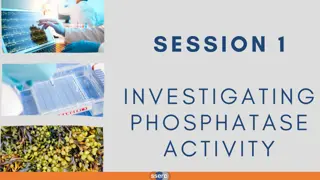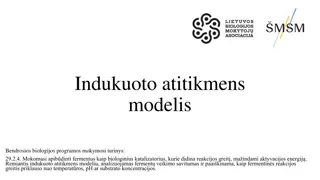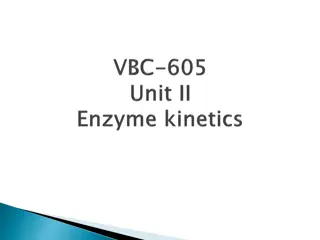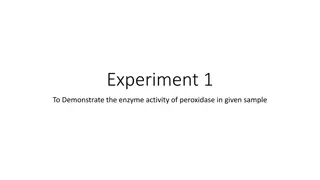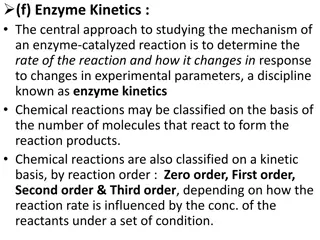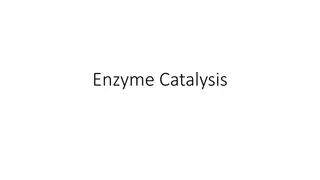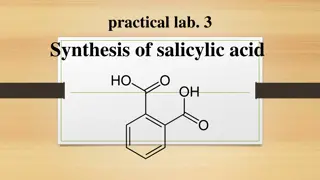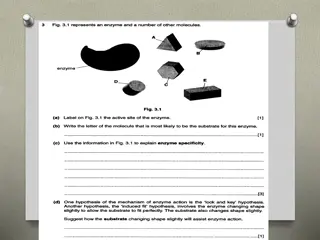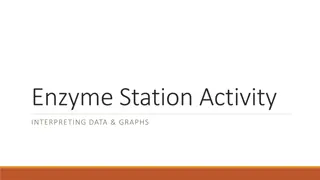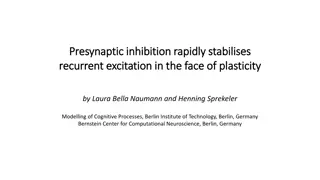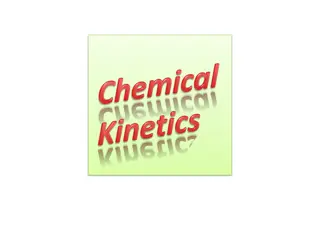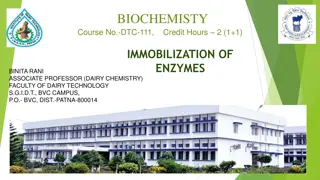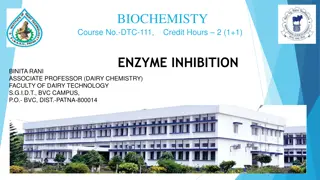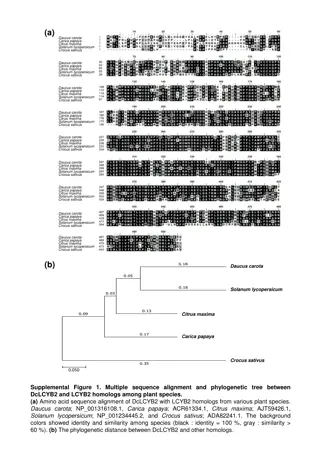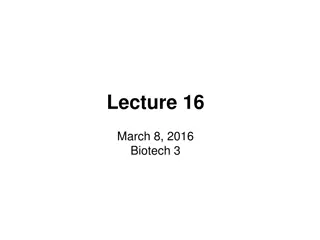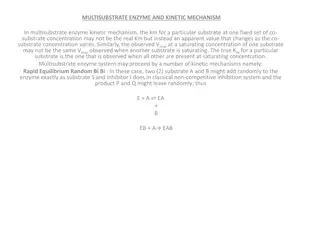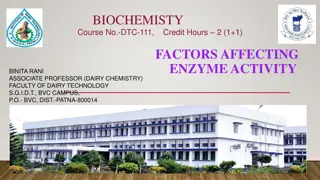Enzyme Inhibition in Acid Phosphatase Kinetics
In this experiment, the effect of inhibitors on enzymatic reactions, specifically acid phosphatase, is explored. Different types of inhibition (competitive, noncompetitive, uncompetitive) are examined, along with reversible and irreversible inhibitors. The study aims to determine the type of inhibition by K2PO4 and sodium fluoride (NaF) on acid phosphatase. Through this investigation, insights into enzyme activity regulation and the impact of inhibitors on enzymatic reactions are gained.
Download Presentation

Please find below an Image/Link to download the presentation.
The content on the website is provided AS IS for your information and personal use only. It may not be sold, licensed, or shared on other websites without obtaining consent from the author.If you encounter any issues during the download, it is possible that the publisher has removed the file from their server.
You are allowed to download the files provided on this website for personal or commercial use, subject to the condition that they are used lawfully. All files are the property of their respective owners.
The content on the website is provided AS IS for your information and personal use only. It may not be sold, licensed, or shared on other websites without obtaining consent from the author.
E N D
Presentation Transcript
322 BCH EXP (8) THE ON THE RATE OF AN ENZYME CATALYZED REACTION EFFECT OF INHIBITORS
In this experiment, we will continue to study acid phosphatase kinetics. Acid phosphatase kinetics Enzyme concentration Substrate concentration Time Temperature pH Inhibitor
OBJECTIVES To study the effect of inhibitors on the rate of an enzymatic reaction. To determine the type of inhibition of acid phosphatase by K2PO4 and sodium fluoride (NaF).
INTRODUCTION Inhibitors are chemicals that reduce the rate of enzymatic reactions. The are usually specific and they work at low concentrations. They block the enzyme but they do not usually destroy it. Since blocking an enzyme's activity can kill a pathogen or correct a metabolic imbalance, many drugs are enzyme inhibitors.
Types of inhibitors Irreversible inhibitors Reversible inhibitors Competitive Noncompetitive Uncompetitive
Irreversible inhibitors Reversible inhibitors Type of bonds with E Inhibitors bind covalently with enzyme Inhibitors covalently with enzyme bind non- Removal Cannot dialysis or other way be removed by Can be removed by dialysis Activity Restoration Permanently active site residues(functional group) which the enzyme become inactive. modify the Removal of the inhibitor restores enzyme activity
It is relatively simple to distinguish the three types of reversible inhibition by comparing the Michaelis-Menten and Lineweaver-Burke kinetics (Vmax and Km) in the presence and absence of the inhibitor.
COMPETITIVE INHIBITORS As the name implies, the inhibitor compete with the substrate for active site of the enzyme. The substrate and inhibitors have resemble structures Have the same Vmax (with I OR without I) Km high and affinity low (with I) This type of inhibition can be overcome by sufficiently high concentrations of substrate by out-competing the inhibitor
NONCOMPETITIVE INHIBITORS The inhibitors bind with site on the enzyme other than active site They can bind with E or ES complex. Have the same Km (with I OR without I) low Vmax (with I)
UNCOMPETITIVE INHIBITORS The inhibitor binds only to the substrate- enzyme complex Both Vmax and Km are low (with I)
METHOD K2PO4 and sodium fluoride are inhibitors of acid phosphatase and it is your task to determine whether they are competitive, noncompetitive, or uncompetitive inhibitor. The setup is basically the same as in the experiment for the effect of substrate concentration on reaction velocity, except that a constant amount of inhibitor is added. The kinetics for the uninhibited reactions must be compared with those of reactions run in the presence of the inhibitor. Determinations of Vmax and Km will help you to determine the specific mode of inhibition
Method Without I With I Place the tubes in a test tube rack situated in 37oC water bath and let stand for 5 min.
Start the reaction by adding 0.5 ml enzyme and stop it by adding 0.5 ml KOH as in the following table: Tube Start the reaction Stop the reaction A B C D E F G H 0 min 0 min 2 min 4 min 6 min 8 min 10 min 12 min 0 min 5 min 7 min 9min 11 min 13 min 15 min 17 min Determine the absorbance at 405 nm for each sample, using the first tube (0 mM of S) as the blank.
RESULTS Tube [S] (mM) 1/[S] (1/mM) Abs at 405 nm Without I V=(A x 106) /(18.8 x 103x time) ( mole of PNP/min) 1/V (1/ mole of PNP/min) With I A B C D E F G H 0 0.5 1 2.5 5 10 25 50
RESULTS Draw the curve using Michaelis-Menten, determine Vmax and Km for acid phosphatase of both inhibited and not inhibited reaction Prepare the double reciprocal plot of Lineweaver-Burk and determine the Km and V max from the x and y intercepts of both inhibited and not inhibited reaction
DISCUSSION An introductory statement [In this experiment, we studied the effect of inhibitors on the rate of acid phosphatase catalyzed reaction. The setup was basically the same as in the experiment for the effect of substrate concentration on reaction velocity, except that a constant amount of inhibitor (K2PO4 or sodium fluoride) was added] Principle Compare the Vmax and Km obtained Michaelis-Menten and Lineweaver- Burk graphs of both inhibited and uninhibited reactions with each other to determine the type of inhibition.
QUESTIONS Determine the type of inhibition of K2PO4 and sodium fluoride. Justify your answer and discuss the difference you find K2PO4 NaF Type of inhibition Resemblance to S structure Binding with E Activity restore Competitive inhibitor Resemble S structure Noncompetitive inhibitor Does not resemble S structure Bind with free E High [S] remove I from the active site Same Vmax, high Km Bind with free E or ES complex High [S] cannot remove I from the active site Low Vmax, same Km Vmax and Km










